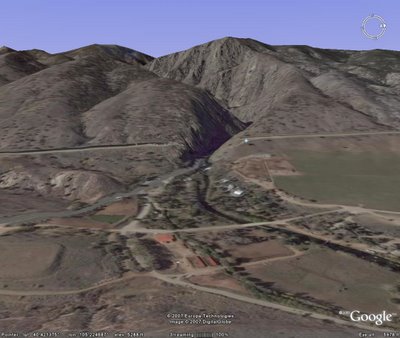I realize that many of my postings haven’t been of a personal nature, so for those of you who read this blog and may have gotten tired of reading articles about energy, here’s something more personal.
A lot of people have been asking to ask me how I like ‘retirement’. For those of you who do not know me personally, I took a voluntary enhanced early retirement from HP in June of last year. I was 47 at the time. One third of HP’s U.S. workforce was eligible for this program, some as young as age 43. Terri and I have been avoiding layoffs for the past 6 years. I’ve survived 3 near layoffs and Terri has survived 4 of them. Prior to that time, it was virtually a given that you could work for HP or Agilent until you reached retirement age, but with much of the high technology industry moving to Asia, that’s no longer the case. Many good people have been forced to find work elsewhere. Dodging layoffs while working harder than ever takes considerable joy out of one’s livelihood.
When HP offered an early retirement incentive program, I felt that it could very well be the last generous voluntary separation package ever offered. I thought it would be good to leave on a high note after 24 years of loyal service. In my last position at HP I had helped to initiate and introduce a new product category of network-attached storage products for the home that resulted in a new charter for my division. I am proud of the products and so I left with a sense of having done something worthwhile as my last contribution to the company. One of my fears about leaving HP was that I didn’t want to do it on bad terms like having my program abruptly cancelled followed by a hasty bum’s rush out the door. There were other divisions reducing staff at the Fort Collins site and some of my colleagues were looking for landing spots. I helped to provide one by leaving the company. I have no regrets about leaving.
My wife and I have no debt and have contributed to our voluntary individual retirement plans for our entire careers. That turned out to be a good thing because my voluntary plan was worth quite a bit more than my standard retirement plan. As many people are finding out, an employer’s defined-benefit pension many not require the employer to actually pay you anything from a legal standpoint. It is within an employer’s rights to amend or cancel virtually any retirement benefit for which there is no contractual obligation. Like most employees, I had no employment contract for my retirement benefits. So getting the equivalent lump sum value of a retirement plan (discounted, of course, to its net present value) can be attractive compared to the risk of getting nothing should an employer be financially unable to meet those obligations some 20 years in the future. I could also feel good about it because I was helping my employer reduce its long term financial obligations. I think that the best thing that has happened since I started working was to move toward making an individual employee’s retirement benefits portable. To make all of my retirement benefits portable, it was necessary to walk away from an established career without the option of being able to return. Leaving a job voluntarily without having another one lined up is viewed in the same realm as renouncing one’s citizenship. Many people think I was laid off. I know a lot of people in that category so even if it were true, I’d be in good company.
For the first part of my ‘retirement dress rehearsal’ as I call it, I did not immediately begin looking for a job. I was able to take a summer off for the first time since I was in grade school. I really enjoyed the time off. It felt revitalizing. However, I quickly began networking to see what opportunities were available for when I was ready to go back to work. The group I have found to be most beneficial in that regard is NoCoNet, which is set up to help Northern Colorado workers and employers to find each other. There are many other benefits to this group besides finding a job and the most significant is meeting lots of new people from around the area that I may have never met otherwise. Many of the new people are volunteers in NoCoNet and other organizations.
Currently, the most promising industries in Northern Colorado are those related to renewable energy. They are the only industries that seem to be attracting any significant investment and showing signs of growth. Everyone seems to realize that it’s just a matter of time before we run out of fossil fuels, the only argument is about how soon it will happen. I think it’s better to be prepared for it than to try to come up with a solution after we no longer have any affordable energy resources. Having access to low cost fossil fuel is a bit like living off an inheritance. When you’re living off an inheritance, it’s a good idea to acquire job skills before you need them so you won’t have to figure out how to do it after you’ve run out of money. So I think it’s wise to invest in alternative energy sources today before we absolutely need it.
That’s one of the reasons why I’ve been researching and posting about energy-related topics. In looking back through my blog, I see I’ve written over 18 entries related to energy topics. Even though I’ve never worked in the energy industry, save for one summer at an electric utility company, I would like to know as much about it as any industry insider. I realize that’s a daunting task, but energy terminology and concepts are familiar to me. Converting from kW to HP to BTUs is something I’ve been doing in my head for as long as I can recall simply because I find the subject of energy fascinating. And I enjoy reading and writing about it as well.
Back in November when Terri found for the second time in 6 months that her new job was moving to Singapore, I applied for a few positions that looked interesting. There’s a company involved in renewable energy that has called a few times but we haven’t set up an interview yet. The last time I talked with them, they thought they’d be interviewing candidates in February. Even though it’s a local position, I’d have to fly to the east coast for the interview. But I don’t know if anything will come of it. Terri managed to find a new position with just a few weeks to spare so it isn’t as important that I get a job as it was a few months ago.
In reality, I don’t really want to be retired in the sense that most people think of it. I wouldn’t be happy spending all my time golfing or lounging on a beach, although I know plenty of people who think they would. Like several of my other friends with whom I’ve talked with about it, happiness requires finding a way to be a productive and contributing member of society. That’s probably true for everyone but some people don’t realize it. I am involved in a few consulting activities I do on a volunteer basis that are related to technology ventures, mostly for friends. I also like to get out and talk with other people regularly so
I generally have a few meetings each week networking with various groups and individuals. And, of course, I participate in Yahoo Groups for products I helped to design. I realized recently that I’ve posted more than 350 entries to the HP Media Vault Yahoo group since retiring. I responded to at least as many email requests in private too, so HP is still getting some work out of me despite my departure.
I haven’t been flying the LongEZ or working on the Cozy as much as I thought I would. It is a surprise to me (and everyone else too) but then again, the weather has been too cold this winter for those activities. We just don’t seem to have the warm spring-like days we used to have at least once a week throughout the winter on Colorado’s Front Range anymore. With Colorado’s 350 days of sunshine per year, it was rare to see it snow on top of snow, except for up in the mountains. We’ve now had snow on our lawn for 2 months, which previously was quite rare, but it happened last year too. I’ve been wondering what’s happened to my global warming dividend.
So there you have it, an update and something a little more personal than my typical blog entry.



